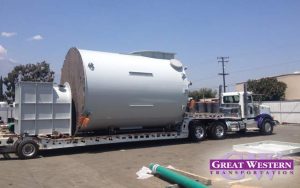Transporting large, bulky equipment such as backhoes, earth movers, cranes and other construction equipment is no easy task. These loads often require special flatbed trailers called lowboys because they are so large. Due to their weight, shape and size, they also have to be properly secured to the flatbed. Federal guidelines specify the type, and number of load securement devices required when transporting heavy machinery.
Types of Securement Devices
Heavy equipment is generally secured using either chains, or webbing, or a combination of the two. Chains should be high tensile strength alloy grade 70 chain that is free from damage and defects. It’s also imperative that end fittings and securing devices such as grab hooks, load binders and cleaves are of the same tensile strength and in good condition. Web strapping, rated to handle the load’s weight can also be used. When using webbing, it’s vital that the straps are cushioned to prevent wear from rubbing on the equipment during transport. Again, end fittings and other components must be of a similar strength to ensure the load is held securely.

Number of Devices Required
The sum total working load limit of the individual chains or straps used to secure the cargo has to be at least half of the weight of the equipment. Therefore, if a load weighs a total of 50,000 pounds, and each securement device has a working load of 5,000, you simply divide the weight by two, you’ll get 25,000 pounds working load. Divide that by the capacity of each strap, in this case, 5,000 pounds, and you’ll see you need 5 devices. However, it may be necessary to add additional straps, or chains, to loads that are extremely top heavy, or over-sized. In addition, chocks and wedges should be used to prevent loads from rolling, or shifting in transit.
Inspecting Securement Devices
It’s imperative that securement devices are thoroughly inspected for any flaws, breaks or weak spots. The same attention should be paid to tie down points on the trailer as well. Before embarking on the trip, drivers must be sure that each device is secured and that the load is ready to roll. Once on the road, drivers must periodically check on the load to assure straps and chains are still secured and that the load hasn’t shifted. These checks should occur during the first 50 miles of the trip, and every 150 miles, or three hours thereafter. Drivers must also be aware of signs that the devices are loosening and are in need of tightening immediately.
Hauling heavy equipment requires a great deal of concentration and a keen understanding of the requirements for securing these huge loads. By following federal guidelines, trucking companies assure that their loads are safely transported and delivered to construction sites and manufacturing facilities all over the country. Their diligent attention to detail also keeps anyone that comes in contact with the load, such as other motorists, dock workers, etc. safe.





